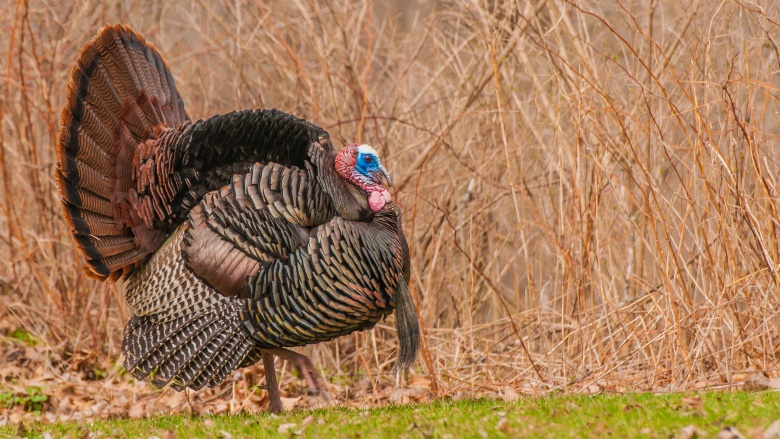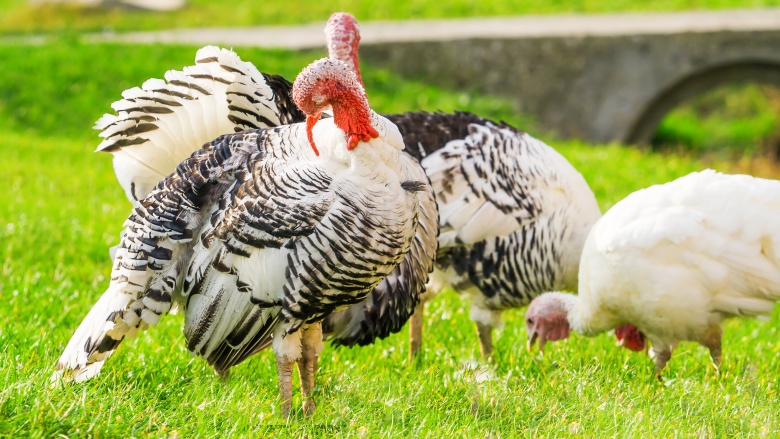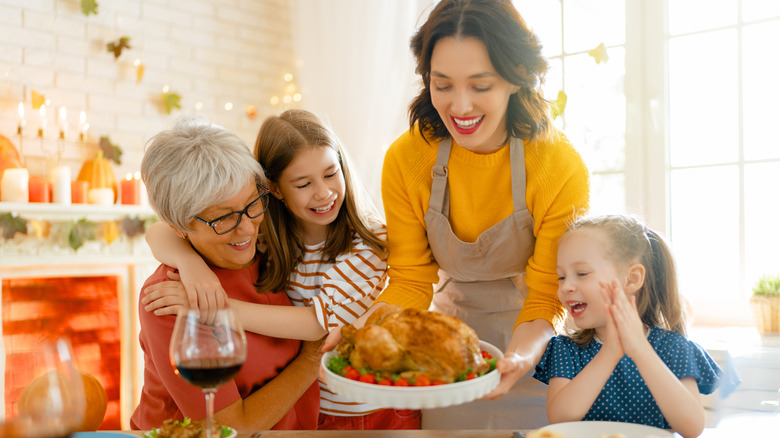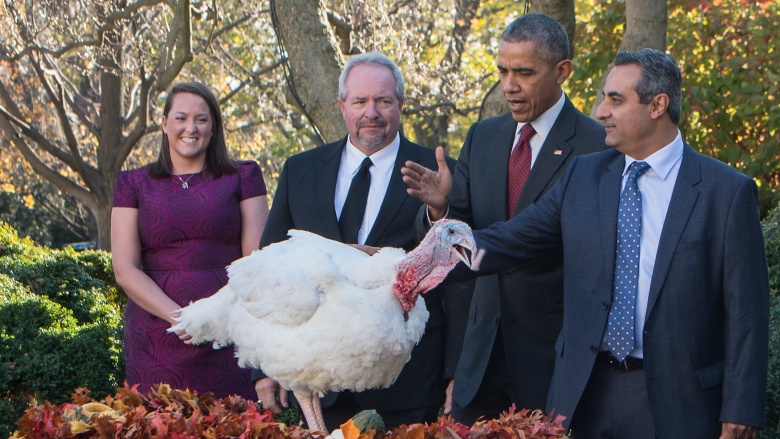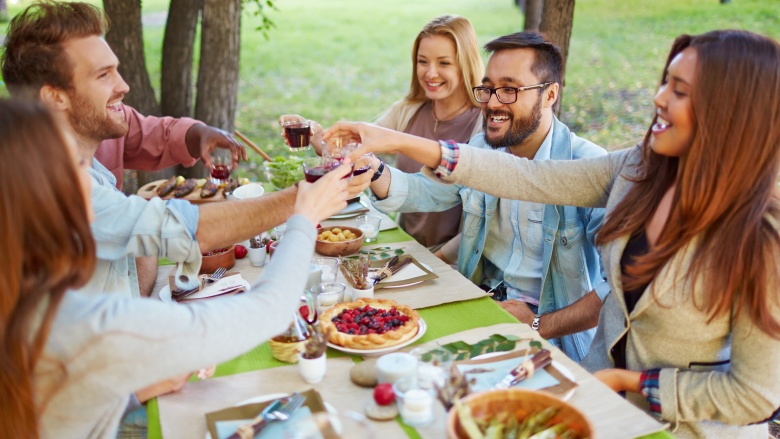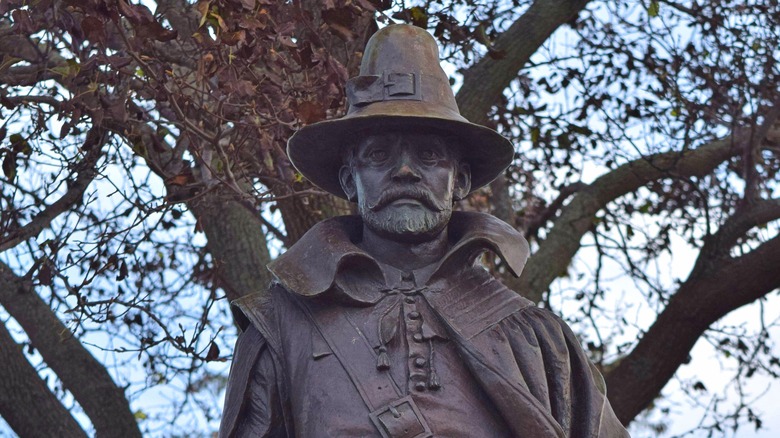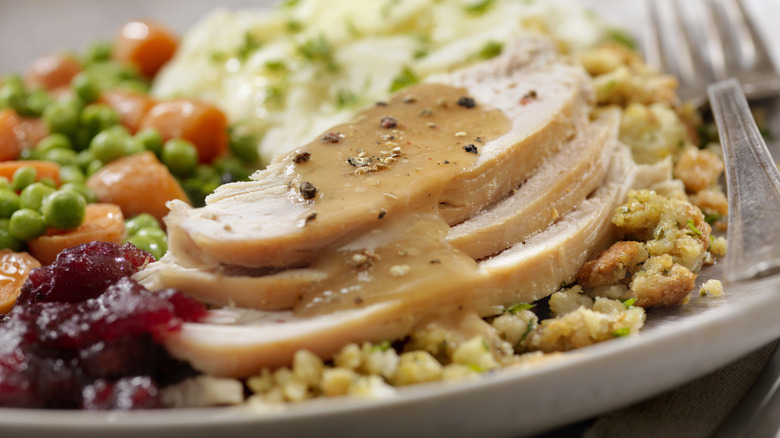The Real Reason We Eat Turkey On Thanksgiving
You can't think about Thanksgiving without thinking about turkey. It's not just the centerpiece of countless dinner tables, it's the stuff of leftover turkey sandwiches, turkey soup, and turkey pot pies. But just why (and when) did the turkey become the Thanksgiving Day staple that it is today? It turns out that there are a few good reasons this giant bird ends up on tables across the country.
They're native birds
When it comes to food sources, you're probably a big fan of convenience. Our ancestors were no different, and part of the reason for the popularity of the turkey is that it's a bird native to North America. The fossil record shows that they've been around for about five million years. They were first domesticated in Mexico centuries before any European set foot on the continent, and it was in the 16th century that settlers brought the big birds northward into what's now America. They also took them to Europe, where they were a huge, exotic hit, and when the first settlements were established along the Atlantic coast, turkeys were right there, too.
Wild turkeys were, for a long time, only found in a handful of places across the country. In the 1940s, numbers were so low that they were introduced into new areas in hopes of reinforcing the dwindling population. Now, they're in all 48 continental states.
They're big ... and pretty useless
"That's an incredibly harsh observation," you say sadly. At least put down the turkey sandwich, first! Part of the necessity of making a family dinner for Thanksgiving is having enough food for all the guests, and since it's always about family, that's always meant making sure there's plenty of meat on the table. Since turkeys are big and one bird can feed a whole family, that makes it easier than sacrificing and cooking a dozen chickens.
There's more to the practicality of this, too. Chickens are valuable for other reasons, most notably their eggs. When you couldn't head down to the grocery store to get your food for the week, people needed to think long-term. In terms of food production, that group of a dozen chickens can keep eggs on the table for a long time after the Thanksgiving meal is over. Other big animals were also more useful alive than as the main course for a single meal. Cows worked in the fields and, along with goats, they produced milk and, in turn, milk products. Pork was incredibly common, and if you were looking at putting together a special feast? Well, the everyday ham and bacon just wouldn't cut it. Turkeys were only around to eat, and you weren't going to be missing out on any other products once they were gone.
Charles Dickens might have had something to do with it
Thanksgiving kicks off the holiday season, and it's common to have turkey at Christmas, too. Some historians think that the two most special dinners of the year are linked, and that it might have something to do with the popularity of Charles Dickens and A Christmas Carol. When the book was published in the 1840s, it introduced an American audience to the idea of a turkey being something extra special. It's what the Cratchit family wants to share most in the world, after all, and not long after the book, turkeys started gaining popularity in the upper levels of society. When turkeys took a dip in price, they were later associated more with the working class and a reminder of how much meat they had, how many family members they could feed, and how money-efficient they were. By then, though, they were firmly entrenched in our holiday traditions.
The influence of Abraham Lincoln
The actual celebration of Thanksgiving dates back (officially, at least) to 1777 when an act of the Continental Congress declared it a real holiday. It was during Abraham Lincoln's presidency, though, that Thanksgiving was declared a nationwide holiday again. That was in 1863, and really, the timing was perfect. The nation had never suffered such a divide as it did with the Civil War, and this was a way to remind everyone of all that they had to be grateful for.
Three years earlier, just after his election, Lincoln had started the tradition with an unofficial Thanksgiving dinner that featured roast turkey, reportedly his favorite meal. By 1864, organizations across the country had picked up the cause of making sure that soldiers had all the trimmings and fixings to celebrate Thanksgiving no matter where they were, and that huge project involved (you guessed it!) collecting turkeys for them.
The Lincoln family is also credited with starting the tradition of issuing a presidential pardon for a most fortunate turkey (even though that historically happened around Christmastime). It's all helped to cement the turkey in its iconic place as a Thanksgiving meal.
So, was the turkey always on the menu for Thanksgiving?
It's one thing that historians don't seem to be able to agree on, even though there's considerable evidence for turkeys being a popular dinnertime menu item for centuries. When it comes to the very first Thanksgiving, you're talking about a harvest celebration that happened in 1621. There are only two eyewitness accounts of what happened during that three-day feast: a letter written by pilgrim Edward Winslow and sent back to England and a written record from Plymouth's governor, William Bradford. While Winslow doesn't mention turkeys at all, Bradford writes, "And besides waterfowl, there was a great store of wild turkeys, of which they took many, besides venison, etc."
That seems to indicate pretty clearly that turkeys were at least there, but it doesn't sound like they were the main dish. In fact, he never actually specifies that they were eaten at the feast. There are plenty of other things that were mentioned by the chroniclers of that first Thanksgiving, and those dishes include venison and "fowl." That likely refers to goose and duck, and fish and lobster probably formed a huge part of that harvest festival meal, too. There were no pies (those weren't a thing yet), but there were plenty of root vegetables and pumpkins in a depressingly non-pie form. As for the centerpiece of the meal? There may not have been one. It did last three days, after all, and that's a lot of feasting to get through. Not to mention the cleaning afterward. When you're cleaning up your own kitchen this year, think of those poor people without dishwashers.
Pilgrims ate turkey, and Thanksgiving sprung from a pilgrim's diary
Among the original group of Church of England separatists, also called Puritans or pilgrims, who came to North America via the Mayflower in 1620 was William Bradford. The governor of the Plymouth Colony for three decades also kept a detailed journal, which would eventually become the prime historical record of the Massachusetts pilgrim era. Those writings covered the years 1621 to 1647 and were available for historians to read until they disappeared in the 1770s. Discovered in a London library in 1855, it was published a year later as "Of Plymouth Plantation."
That visceral, historically accurate account of pilgrim life created a cultural sensation around the entire United States. The biggest takeaway was that Bradford and the other pilgrims celebrated Thanksgiving as a holiday. To that point, it had been a regional celebration in New England, spreading not far from Plymouth Rock in Massachusetts. "Of Plymouth Plantation" helped spark a movement to make Thanksgiving a national holiday, with turkey the main course of the central feast. The reason: Bradford wrote of his fellow pilgrims hunting turkeys in the 1620s, a bird native to North America and wildly abundant at the time.
It's the perfect special occasion meal
As anyone who has ever been stressed out over the intricate and labor-intensive preparation of a Thanksgiving dinner can attest, it's not easy to cook a turkey. It takes a long time to cook a bird that weighs in at around an average of 15 pounds, no matter the preparation method, particularly the traditional way of roasting one in an oven. Over the course of several hours, home cooks must periodically ensure that the turkey is roasting properly, not taking too long or getting dried out, and maybe occasionally basting and checking on the stuffing, too.
Making a turkey just isn't something a lot of people have the time or patience to tackle on a regular weekday for a family dinner. But on Thanksgiving, a federal holiday that relieves millions of people from their day jobs, there are plenty of hours available to give the turkey the time and attention it needs. We eat turkey on Thanksgiving because it's one of the few days that we can.

